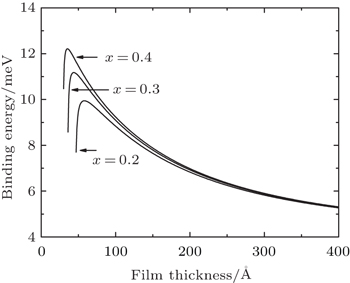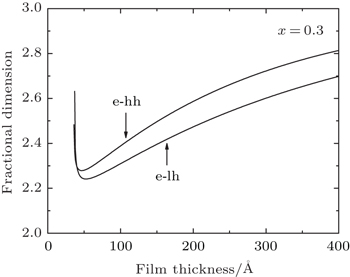† Corresponding author. E-mail:
Project supported by the National Natural Science Foundation of China (Grant No. 11304011) and the Fundamental Research Funds for the Central Universities, China.
Binding energies of excitons in GaAs films on AlxGa1−xAs substrates are studied theoretically with the fractional-dimensional approach. In this approach, the real anisotropic “exciton + film” semiconductor system is mapped into an effective fractional-dimensional isotropic space. For different aluminum concentrations and substrate thicknesses, the exciton binding energies are obtained as a function of the film thickness. The numerical results show that, for different aluminum concentrations and substrate thicknesses, the exciton binding energies in GaAs films on AlxGa1−xAs substrates all exhibit their maxima with increasing film thickness. It is also shown that the binding energies of heavy-hole and light-hole excitons both have their maxima with increasing film thickness.
In the last few decades, a large amount of work has been devoted to the research on the physics character of exciton, polaron, and impurity properties of semiconductor heterostructures, such as quantum wells, quantum wires, quantum dots, superlattices, films on substrates, etc. Such interest has arisen due to the physics nature underlying various properties of these systems and the potential applications in a wide range of electronic and optoelectronic devices. In fact, excitons have great effects on a variety of physical phenomena observed in these structures. Therefore understanding these properties such as the increase in the exciton binding energy due to the confinement of the carriers has become an important topic in the study of low-dimensional structures in the last few decades.
Since the pioneering work on exciton in a polar crystal by Haken,[1] a great deal of work has been devoted to study the excitonic properties in films theoretically and experimentally. Several authors calculated the binding energies of excitons in free-standing GaAs films by using variational schemes.[2] The optical spectroscopy of large-momentum excitons in GaAs films was experimentally and theoretically investigated by some researchers.[3,4] Photoluminescence (PL) spectrum measurements were used to study exciton[5,6] and exciton–polariton[7] problems and to determine the exciton binding energies[8,9] in various semiconductor films, such as CdS, ZnSe, GaN, and CsSnI3 films. In particular, the GaAs film on AlxGa1−xAs substrate is an important semiconductor low-dimensional structure. As far as we know, there is not much work on the exciton properties in a GaAs film on an AlxGa1−xAs substrate.
Of particular interest to the present work is the fractional-dimensional approach (FDA) first proposed by He[10–13] to study excitons and optical properties of anisotropic solids. In this approach, the Schrödinger equation for a real anisotropic system is solved in a noninteger-dimensional space where the interactions are assumed to occur in an isotropic effective environment, and the essential quantity is the fractional dimension D associated with the effective medium and the degree of anisotropy of the actual system. In the last few years, the FDA has been successfully used in the study of the excitons,[14–18] biexcitons,[19–21] magnetoexciton,[22–24] excitonic and impurity states,[23,25–30] polarons,[31–34] and exciton–phonon interaction[35–38] in anisotropic semiconductor heterostructures. However, to the best of our knowledge, the FDA has not been extended to investigate excitons in a GaAs film on an AlxGa1−xAs substrate.
In our preview work, we used the FDA to study the polaron effect in a GaAs film deposited on AlxGa1−xAs substrate.[39–41] In this paper, we extend the FDA to the case of an exciton confined to a GaAs film on AlxGa1−xAs substrate. Within the FDA, the exciton + GaAs film system is realistically described by an equivalent isotropic hydrogenic system in a fractional D-dimensional space, a problem which can be solved analytically. As functions of the film thickness, the exciton binding energies are calculated. This paper is organized as follows. In Section 2, the theoretical framework of the FDA is extended to the case of excitons confined in GaAs films on AlxGa1−xAs substrates. Numerical results and discussion are given in Section 3, and conclusions are given in Section 4.
Let us consider the problem of an exciton confined in a semiconductor GaAs film on AlxGa1−xAs substrate (growth axis along the z direction). Within the effective mass and the parabolic band approximations, the Hamiltonian for the exciton can be given by



Using the FDA proposed by He,[10–13] the exciton problem in an anisotropic solid can be treated as one in an isotropic fractional-dimensional space whose dimension D depends on the degree of anisotropy of the real system. By utilizing the Laplacian operator proposed by Stillinger,[42] who proposed axioms and operators for a noninteger-dimensional space, the discrete bound-state energies and orbital radii are given by

According to Eq. (




In our GaAs film–AlxGa1−xAs substrate system, within the effective mass and the parabolic band approximations, the Hamiltonian for the single electron (j = e) or hole (j = h) can be given by

The dimensional parameter D that guarantees the mapping of the real system into the fractional-dimensional space can be calculated through the relation[31]


In the case of an exciton confined in a GaAs film on AlxGa1−xAs substrate, the exciton is no longer restricted to the region inside the film only. Therefore, the spreading of the exciton wave function into the substrate has to be considered in defining the corresponding length of confinement. Taking into account the spatial extension of the exciton motion in the substrate region, the length of confinement is characterized by an effective film thickness 


On the other hand, the effective length that characterizes the electron–hole interaction is the mean value of the effective Bohr diameter of the 3D exciton


Therefore, the dimensional parameter D can be calculated through the relation

In the GaAs film–AlxGa1−xAs substrate system, the material parameters which characterize the exciton properties differ when passing from the film to the substrate region. In other words, the effective-mass mismatch between the film and the substrate materials should be considered. In order to take this fact into account, we may assign the effective fractional-dimensional space an average of the material parameters over the exciton positions. The mean values of the material parameters can be calculated in the same manner as in Ref. [43]. In this way, they enter in the Hamiltonian of the system and weight the spatial integration with the square module of the electron (j = e) and hole (j = h) wave functions Ψj(zj) determined by Hj (Eq. (


Finally, the binding energy of an exciton confined in a GaAs film on AlxGa1−xAs substrate can be obtained in an analytical way from Eqs. (
The binding energy of the heavy-hole exciton in the GaAs film on AlxGa1−xAs substrate as a function of the film thickness is displayed in Fig.
 | Fig. 1. The heavy-hole exciton binding energy in the GaAs film on AlxGa1−xAs substrate as a function of the film thickness for different Al concentrations at the substrate thickness Ls = 20 Å. |
The fractional dimension D corresponding to the fractional-dimensional result in Fig.
 | Fig. 2. The corresponding fractional dimension D as a function of the film thickness for different Al concentrations at the substrate thickness Ls = 20 Å. |
The binding energy of the heavy-hole exciton in the GaAs film on Al0.3Ga0.7As substrate as a function of the film thickness is displayed in Fig.
 | Fig. 3. The heavy-hole exciton binding energy in the GaAs film on Al0.3Ga0.7As substrate as a function of the film thickness at different substrate thicknesses Ls = 20 Å, 50 Å, 100 Å. |
The fractional dimension D corresponding to the fractional-dimensional result in Fig.
 | Fig. 4. The corresponding fractional dimension D as a function of the film thickness at different substrate thicknesses Ls = 20 Å, 50 Å, 100 Å. |
The binding energies for the heavy-hole and light-hole excitons in the GaAs film on Al0.3Ga0.7As substrate as a function of the film thickness are displayed in Fig.
 | Fig. 5. The binding energy for the heavy-hole and light-hole excitons in the GaAs film on Al0.3Ga0.7As substrate as a function of the film thickness at the substrate thickness Ls = 20 Å. |
The fractional dimension D corresponding to the fractional-dimensional result in Fig.
We have used the FDA, in which the real anisotropic semiconductor system is mapped into an effective isotropic space with a fractional dimension, to study the exciton binding energies in GaAs films on AlxGa1−xAs substrates. For different aluminum concentrations and substrate thicknesses, the exciton binding energies are obtained as a function of the film thickness. The numerical results show that, for different aluminum concentrations and substrate thicknesses, the exciton binding energies in GaAs films on AlxGa1−xAs substrates all exhibit their maxima with increasing film thickness. It is also shown that the binding energies of heavy-hole and light-hole excitons both have their maxima with increasing film thickness. Moreover, the heavy-hole exciton binding energy is larger than the light-hole one at a certain film thickness, which is quite different from the case of excitons in GaAs-AlxGa1−xAs quantum wells.
| 1 | |
| 2 | |
| 3 | |
| 4 | |
| 5 | |
| 6 | |
| 7 | |
| 8 | |
| 9 | |
| 10 | |
| 11 | |
| 12 | |
| 13 | |
| 14 | |
| 15 | |
| 16 | |
| 17 | |
| 18 | |
| 19 | |
| 20 | |
| 21 | |
| 22 | |
| 23 | |
| 24 | |
| 25 | |
| 26 | |
| 27 | |
| 28 | |
| 29 | |
| 30 | |
| 31 | |
| 32 | |
| 33 | |
| 34 | |
| 35 | |
| 36 | |
| 37 | |
| 38 | |
| 39 | |
| 40 | |
| 41 | |
| 42 | |
| 43 |




